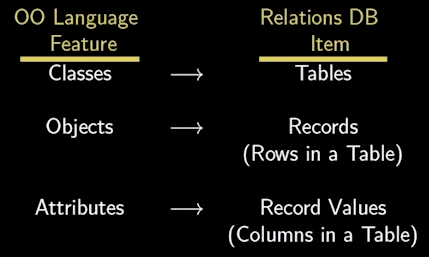Python工具箱系列(三十四)
SQLAlchemy是著名的ORM(Object Relational Mapping-对象关系映射)框架。其主要作用是在编程中,把面向对象的概念跟数据库中表的概念对应起来。对许多语言(例如JAVA/PYTHON)来说就是定义一个对象,并且这个对象对应着一张数据库的表。而这个对象的实例,就对应着表中的一条记录。
其整体思路如下图所示:

其中类、对象与属性与数据库相关内容的对应关系如下图所示:

ORM的优点:
-
数据模型与代码统一定义,更新与维护简单,代码高度重用一致。
-
ORM有现成的工具,很多功能都可以自动完成,比如表格增删、预处理、事务等。
-
基于ORM的业务代码比较简单,代码量少,语义性好,容易理解。
-
你不必编写性能不佳的SQL。
ORM的缺点:
-
ORM库多层封装,实现巧妙,需要花很多精力学习和设置。
-
对于复杂的查询,ORM要么是无法表达,要么是性能不如原生的SQL。
-
ORM抽象掉了数据库层,开发者无法了解底层的数据库操作,也无法定制一些特殊的SQL。
从整体上看,ORM节省了开发时间,减少了代码错误的可能性,同时能够方便地在多个数据库间灵活迁移,还是非常值得使用。而在python语言中,SQLAlchemy是著名的ORM框架之一,它的整体架构如下图所示:

从图中可以看出,SQLAIchemy是分层架构,由Core以及ORM两部分组成。其中,Core完成了与数据库操作的各类封闭,是相对低层的。而ORM层则利用Core层的能力进行更宏观的操作。因此,在一段python代码中,使用Core与ORM层同时来操作数据库也是可行的,并不矛盾与冲突。
下面先从最基本的表格创建做起。非ORM编程中,表格的创建无非两个途径:
●基于DBMS本身提供的CLI/GUI界面,发出DDL语句进行数据库/表格本身的增删改查。
●使用语言连接数据库后,发出命令来对数据库/表格进行增删改查。
而由于每种数据库都有自己的方言,所以命令语句各有差异,需要不断地调整。而使用SQLAlchemy则实现了代码统一。例如以下代码在mssql以及mysql上创建表格,并且可以查询表格的元数据,以及插入数据后的查询。
from sqlalchemy import (Column, Integer, MetaData, String, Table, create_engine, text, Float, DateTime, ForeignKey) from sqlalchemy_utils.functions import create_database, database_exists configure_pg = {"user": "postgres", 'password': '88488848', 'dns': 'dbserver.home', "port": 5432, 'prefix': 'postgresql+psycopg2', 'postfix': '' } configure_mssql = {"user": "sa", 'password': '88488848', 'dns': 'dbserver.home', "port": 1433, 'prefix': 'mssql+pymssql', 'postfix': '?charset=utf8' } configure_mysql = {"user": "root", 'password': '88488848', 'dns': 'dbserver.home', "port": 3306, 'prefix': 'mysql+mysqlconnector', 'postfix': '' } config = {'mssql': configure_mssql, 'mysql': configure_mysql, 'postgresql': configure_pg} database_name = 'testdb' table_sensor_location = "sensor_location" table_sensor_data = "sensor_data" def linkdb(targetstr): """ 连接不同的数据库 Args: targetstr (string): 数据库名称 Returns: engine: 用于后续的数据库连接 """ if targetstr in config.keys(): item = config[targetstr] connectstring = f"{item['prefix']}://{item['user']}:{item['password']}@{item['dns']}:{item['port']}/{database_name}{item['postfix']}" engine = create_engine(connectstring, echo=True, future=True) # 如果数据库不存在,则创建之 if not database_exists(engine.url): create_database(engine.url) # 做一个测试,不针对任何表 with engine.connect() as conn: result = conn.execute(text("select 'hello world'")) print(result.all()) return engine def createtbs(connector): """" 创建数据库中的2张表。用于保存传感器数据与传感器本身的信息 """ metadata_obj = MetaData() # 描述传感器的表 sensor_location_tb = Table( table_sensor_location, metadata_obj, Column('id', Integer, primary_key=True, autoincrement=False), Column('location', String(30), nullable=False) ) # 保存传感器数据的表 sensor_data_tb = Table( table_sensor_data, metadata_obj, Column('id', Integer, primary_key=True, autoincrement=False), Column('sensor_id', ForeignKey( f'{table_sensor_location}.id'), nullable=False), Column('area', String(30)), Column('pm25', Float), Column('timestamp', DateTime) ) print(sensor_data_tb.compile()) # 创建并返回表 metadata_obj.create_all(connector) return sensor_data_tb, sensor_location_tb def tableinfo(connector, tablename): """ 获得指定表名的相关元数据信息 Args: connector (engine): 数据库连接器 tablename (string): 要查询的表名 """ metadata_obj = MetaData() some_table = Table(tablename, metadata_obj, autoload_with=connector) print([c.name for c in some_table.columns]) def gensonsorinfo(connector): with connector.connect() as conn: conn.execute(text(f"INSERT INTO {table_sensor_location} (id, location) VALUES (:x, :y)"), [{"x": 1, "y": '1号楼'}, {"x": 2, "y": '2号楼'}]) conn.commit() result = conn.execute( text(f"SELECT id, location FROM {table_sensor_location}")) for x, y in result: print(f"id: {x} location: {y}") # 依次连接多个数据库。从而验证代码的一致性 for dbname in config.keys(): con = linkdb(dbname) createtbs(con) tableinfo(con, table_sensor_data) tableinfo(con, table_sensor_location) gensonsorinfo(con)
从代码可以看出,可以用统一的访问方式来操作mssql/mysql/postgresql三种数据库。而且,以上方式与前文中的基于游标的写法类似。